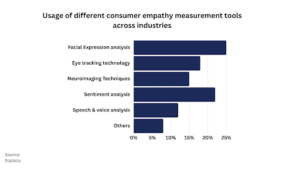Business
Measuring Consumer Empathy: Tools for Assessing Emotions in Market Research

In today’s highly competitive business landscape, understanding consumer emotions has become a critical differentiator for companies striving to gain a competitive edge. Empathy involves resonating with and understanding customers’ feelings and experiences. Empathy drives successful marketing and brand loyalty. As Harvard Business Review reports, companies that show consumer empathy outperform competitors. They do so by a huge increase in sales growth.
This blog post explores the tools revolutionizing market research. They measure and harness customer empathy in new ways. These methods are cutting-edge. They analyze facial expressions and use new brain imaging. They give invaluable insights into consumer emotions, preferences, and decision-making.
Understanding Consumer Empathy
Before delving into the tools, it’s essential to grasp the significance of consumer empathy and its impact on purchasing decisions and brand loyalty. Consumer empathy is defined as the ability to comprehend and resonate with customers’ emotions, motivations, and experiences. Empathy goes beyond meeting consumer needs; it involves deeply understanding their emotional states and tailoring products, services, and marketing strategies accordingly.
Consumer empathy is very powerful. This is clear from Accenture’s findings. They show that 87% of consumers are more likely to buy if a company gives them personalized experiences. These experiences show an understanding of their needs. By tapping into this emotional connection, businesses can foster lasting brand loyalty and drive sales growth.
In today’s globalized market, cultivating global consumer empathy has become a crucial differentiator for companies seeking to resonate with diverse audiences across cultures and regions.
Tools for Measuring Consumer Empathy
Market researchers have access to a suite of advanced tools that unlock unprecedented insights into behavior. Let’s explore some of the most powerful and effective techniques:
Facial Expression Analysis
Facial expression analysis is a cutting-edge technology. It uses computer vision and machine learning to decode the emotions of consumers. It does this by analyzing their facial movements and expressions. This tool has proven remarkably accurate, with Forbes reporting a 75% accuracy rate in determining consumer emotions in empathy research studies.
One notable example of facial expression analysis in action is a study conducted by a leading automotive company. Researchers tracked participants’ facial expressions while watching car commercials. They found which ads resonated most with viewers and made them feel good. This valuable data informed the company’s subsequent marketing campaigns, resulting in a significant increase in sales and brand engagement.
Neuroimaging Techniques
Neuroimaging techniques, such as functional magnetic resonance imaging (fMRI) and electroencephalography (EEG), offer a window into the subconscious mind of consumers. These methods measure brain activity and neural responses. They provide insights into consumer preferences and decision-making. These insights may not be consciously spoken.
Research published in ScienceDirect says that fMRI can predict consumer preferences with 90% accuracy. It does this based on brain activity. This precision is remarkable. It helps businesses make products and campaigns that deeply resonate with their target audience.
Eye Tracking Technology
Eye-tracking technology is another powerful tool in the market researcher’s arsenal. By tracking where consumers focus their visual attention, this technology reveals valuable insights into emotional responses and decision-making processes. A study published on SpringerLink highlights this. It shows that eye tracking can find which parts of ads or products catch consumers’ attention. They do this within the first 3-5 seconds, and it influences purchasing decisions.
A notable application of eye-tracking technology was a study conducted by a leading retail brand. By analyzing consumers’ eye movements while browsing their websites, the company identified areas of frustration and confusion in the user experience. Armed with these insights, they optimized their website, resulting in a significant boost in online sales and customer satisfaction.
Sentiment Analysis
In the age of social media and online reviews, sentiment analysis tools have emerged as indispensable assets for gauging consumer empathy. The algorithms are advanced. They analyze text, like customer feedback and social media posts. They find valuable insights into consumer feelings, wants, and pains.
Sentiment analysis tools can process thousands of customer reviews in minutes. They give businesses valuable insights into consumer emotions and preferences. This data can inform product development, marketing, and customer service. It ensures that companies stay aligned with the changing needs and feelings of their target audience.
Best Practices for Implementing Tools
While these advanced tools offer unprecedented consumer insights, their effectiveness hinges on proper implementation and adherence to best practices:
Integration of Multiple Tools
To fully understand consumer empathy, you must use many tools. MarketWatch’s report highlights that facial expression analysis, eye tracking, and sentiment analysis can give a 360-degree view of consumer emotions. These methods improve the accuracy of empathy insights.

Cultural Nuances and Individual Differences
You must consider cultural nuances and individual differences. Do this when interpreting data from research tools. A study in Frontiers in Psychology emphasizes this. It says that cultural differences in facial expressions affect how emotions are seen. It highlights the need to validate these tools across cultures.
Ethical Considerations
When using advanced measurement tech, businesses must put ethics first. They must keep the highest standards for data privacy and consent. An article in the Journal of Business Ethics underscores the need for informed consent from participants. It also stresses the need for data privacy to keep high ethical standards.
Comparison Table
The tools have many features, strengths, and uses. To help you understand them, we’ve made a table comparing them.
| Tool | Key Features | Strengths | Applications |
| Facial Expression Analysis | Analyzes facial movements and expressions using computer vision and machine learning | Highly accurate in determining [consumer empathy], up to 75% accuracy | Evaluating emotional responses to advertisements, product designs, and marketing campaigns |
| Neuroimaging Techniques | Measures brain activity and neural responses using fMRI and EEG | Provides insights into subconscious consumer preferences and decision-making processes, up to 90% accuracy | Predicting consumer preferences, optimizing product designs, and understanding subconscious motivations |
| Eye Tracking Technology | Tracks visual attention and eye movements | Reveals which elements capture consumer attention within the first few seconds, influencing purchasing decisions | Optimizing website and product designs, identifying areas of frustration or confusion |
| Sentiment Analysis | Analyzes textual data from customer feedback, social media, and online reviews | Processes large volumes of data quickly, providing insights into [consumer empathy] and preferences | Informing product development, marketing strategies, and customer service initiatives |
FAQs
1. How reliable are these tools in capturing consumer emotions accurately?
Experts have rigorously validated the tools in this blog post. They have also tested their reliability. For instance, reading faces has been proven to reach 75% accuracy in gauging consumer empathy. Also, brain scans can predict preferences with up to 90% accuracy based on brain activity.
Additionally, these tools have been adopted and have shown their effectiveness in many successful applications. They follow industry standards and best practices to ensure accuracy.
2. Are there any limitations or challenges in using these tools for measuring consumer empathy?
These tools offer great insights. But, we must consider their limits and challenges. Cost and tech limits can be barriers. Some techniques need special gear and trained staff.
Also, cultural and individual differences can impact data interpretation. This requires cross-cultural validation and careful consideration of these factors. Businesses should also invest in cross-cultural training. They should collaborate with experts to interpret data and address biases.
3. How can businesses turn the insights from these tools into marketing strategies they can act on?
Doing this requires a strategic, data-driven approach. You must turn insights about consumer empathy into actionable marketing strategies. Businesses should form cross-functional teams. The teams should include experts in market research, product development, marketing, and customer experience. Their job is to analyze and interpret the data together.
Case studies have shown that businesses can use these insights to improve product designs. They can also improve marketing campaigns. They can make customer experiences better. They can develop targeted strategies that resonate with their audience.
Conclusion
Consumer behavior and preferences keep changing. Measuring empathy has become critical for businesses that want to thrive. Advanced tools, like facial expression analysis and neuroimaging, offer new chances to decode consumer emotions, preferences, and decision-making. Eye-tracking and sentiment analysis are among these tools.
Businesses that embrace these tools and follow best practices in using them can gain a deep understanding of their target audience. This understanding helps to build lasting emotional connections and drive sales growth. With these insights, companies can make products, services, and marketing that resonate with consumers. This paves the way for lasting success and brand loyalty.
Call to Action
Embark on a journey of consumer empathy by exploring the transformative potential of these advanced tools. Unlock a world of untapped empathy insights and harness the power of emotional intelligence to elevate your business to new heights. Contact the team of market research experts today to learn how they can help you leverage these cutting-edge technologies and gain a competitive advantage in your industry.
Business
Coomersu: The New Era of Commerce and User Engagement

Introduction
In today’s fast-paced and ever-evolving global marketplace, businesses are constantly on the lookout for innovative strategies to stay ahead of the competition. One such groundbreaking concept that has emerged is Coomersu—a dynamic fusion of commerce and user engagement that is reshaping the way companies interact with their customers. This article will explore the essence of Coomersu, its significance, applications, and the myriad benefits it offers in the contemporary business landscape.
What is Coomersu?
Coomersu is a portmanteau of “commerce” and “user,” reflecting a revolutionary approach that emphasizes the integration of user-centric strategies within commercial enterprises. Unlike traditional commerce models that focus primarily on transactions, Coomersu is centered around building robust relationships with customers. It involves creating memorable experiences, fostering loyalty, and driving meaningful interactions.

The Evolution of Commerce
Historical Context of Commerce
Commerce has come a long way from its rudimentary beginnings in bartering and simple trade. Over centuries, it has evolved through various stages—from local marketplaces to global e-commerce platforms. Traditional commerce was heavily transaction-focused, prioritizing the exchange of goods and services over customer experience.
How User Engagement Has Changed Over Time
As technology advanced and consumer expectations grew, businesses began to recognize the importance of engaging with users on a deeper level. The rise of digital platforms and social media has transformed how companies connect with their audience. Today, user engagement is not just about providing a service or product; it’s about creating a holistic experience that resonates with customers on an emotional and personal level.
Key Principles of Coomersu
User-Centric Strategies
At the heart of Coomersu is the principle of user-centricity. This approach involves tailoring strategies to meet the unique needs and preferences of customers. It goes beyond mere customer service to encompass a deeper understanding of user behavior, preferences, and feedback.
Building Relationships vs. Transactions
While traditional commerce focuses on completing transactions, Coomersu prioritizes building lasting relationships with customers. This shift from a transactional to a relational mindset helps businesses create a loyal customer base and drive repeat business.
Creating Memorable Experiences
Coomersu emphasizes the creation of memorable experiences that leave a lasting impression on customers. Whether through personalized interactions, exceptional service, or engaging content, the goal is to make every customer touchpoint meaningful and impactful.
The Benefits of Coomersu
Enhanced Customer Loyalty
One of the primary benefits of adopting Coomersu strategies is the enhancement of customer loyalty. By focusing on user engagement and relationship-building, businesses can foster a sense of loyalty among their customers, leading to higher retention rates and long-term success.
Improved Customer Satisfaction
Coomersu also leads to improved customer satisfaction. When customers feel valued and understood, they are more likely to have positive experiences and provide favorable feedback. This, in turn, enhances the overall reputation of the business.
Increased Brand Advocacy
Satisfied and loyal customers often become brand advocates, promoting the business through word-of-mouth and social media. Coomersu strategies help cultivate this advocacy by ensuring that customers have exceptional experiences worth sharing.
Applications of Coomersu
E-commerce Platforms
In the realm of e-commerce, Coomersu can be applied through personalized shopping experiences, tailored recommendations, and interactive customer support. E-commerce platforms that leverage Coomersu principles can create more engaging and user-friendly environments.
Retail Experiences
For brick-and-mortar stores, Coomersu involves creating immersive and personalized shopping experiences. This can include interactive displays, personalized service, and loyalty programs that enhance the overall in-store experience.
Digital Marketing Strategies
Coomersu principles can also be integrated into digital marketing strategies. This includes personalized content, targeted advertisements, and interactive campaigns that resonate with users and drive engagement.
Implementing Coomersu in Your Business
Steps to Adopt Coomersu Strategies
Adopting Coomersu strategies involves several key steps. Begin by understanding your target audience and gathering insights into their preferences and behaviors. Next, develop user-centric strategies that align with these insights and integrate them into your business operations.
Tools and Technologies for Effective Implementation
To effectively implement Coomersu, businesses can leverage various tools and technologies, such as customer relationship management (CRM) systems, data analytics platforms, and marketing automation tools. These technologies help streamline user engagement efforts and provide valuable insights into customer interactions.
Challenges in Adopting Coomersu
Potential Obstacles
While the benefits of Coomersu are significant, businesses may encounter challenges in its adoption. These challenges can include resistance to change, resource constraints, and difficulties in implementing new technologies.
Solutions to Overcome These Challenges
To overcome these challenges, businesses should focus on gradual implementation, invest in training and development, and seek expert guidance if needed. Building a culture of user-centricity within the organization can also help address resistance and drive successful adoption.
Case Studies of Coomersu in Action
Successful Examples from Various Industries
Several businesses have successfully adopted Coomersu strategies and reaped the rewards. For example, companies in the retail and e-commerce sectors have seen significant improvements in customer loyalty and satisfaction by implementing personalized and engaging experiences.
Lessons Learned and Best Practices
From these case studies, businesses can learn valuable lessons and identify best practices for implementing Coomersu. Key takeaways include the importance of understanding user needs, leveraging technology effectively, and maintaining a focus on relationship-building.
The Future of Coomersu
Emerging Trends and Innovations
The future of Coomersu is likely to be shaped by emerging trends and innovations. Advances in artificial intelligence, machine learning, and data analytics will further enhance user engagement and personalization capabilities.
Predictions for the Evolution of User-Centric Commerce
As Coomersu continues to evolve, we can expect an increased emphasis on hyper-personalization, seamless omnichannel experiences, and greater integration of user feedback into business strategies.
Conclusion
Coomersu represents a transformative shift in commerce, emphasizing the importance of user engagement and relationship-building. By adopting Coomersu principles, businesses can enhance customer loyalty, improve satisfaction, and drive long-term success. As we move forward, embracing this user-centric approach will be crucial for staying competitive in the ever-changing marketplace.
FAQs
What exactly is Coomer’su?
Coomer’su is a concept that combines commerce with user engagement, focusing on building relationships, creating memorable experiences, and fostering customer loyalty.
How can Coomer’su benefit my business?
Coomer’su can benefit your business by enhancing customer loyalty, improving satisfaction, and increasing brand advocacy through user-centric strategies and personalized interactions.
What are the key challenges in implementing Coomer’su?
Key challenges in implementing Coomer’su include resistance to change, resource constraints, and difficulties in integrating new technologies. Addressing these challenges requires gradual implementation, training, and a focus on user-centricity.
Can small businesses adopt Coomer’su strategies?
Yes, small businesses can adopt Coomer’su strategies by focusing on understanding their customers, leveraging affordable tools and technologies, and implementing user-centric practices within their operations.
What are some real-world examples of Coomer’su?
Real-world examples of Coomer’su include personalized shopping experiences in e-commerce, interactive retail displays, and targeted digital marketing campaigns that engage users and enhance their overall experience.
Business
Is Shein Shutting Down? Latest Updates

Introduction
Shein’s Current Status
Recent headlines have sparked curiosity and concern among Shein’s vast customer base. Despite the buzz, it’s crucial to differentiate between speculation and verified information. As of the latest updates, Shein has not officially announced any plans to shut down. The company continues to operate its online platform and retail activities globally. Statements from Shein’s management indicate that while there are challenges, there is no immediate plan for closure.
Reasons Behind the Speculation
Several factors have fueled the speculation about Shein’s potential shutdown:
- Financial Issues: Shein, like many businesses, faces financial pressures, including rising costs and fluctuating revenues. However, financial challenges are common in the retail sector and do not necessarily indicate an impending shutdown.
- Market Competition: The fashion industry is highly competitive, with numerous brands vying for consumer attention. Shein faces stiff competition from both established and emerging brands, which can contribute to market rumors.
- Supply Chain Challenges: Disruptions in the global supply chain have affected many businesses, including Shein. These disruptions can lead to delays and increased costs, fueling speculation about the company’s stability.
Shein’s Business Model
Shein’s success can be attributed to its innovative business model, which focuses on fast fashion. The company is known for its rapid production cycles and extensive inventory, allowing it to offer the latest trends at competitive prices. Shein’s global reach, with its online presence spanning multiple countries, has cemented its position in the fashion industry. Understanding Shein’s business model provides context for the challenges it faces and the speculations surrounding its future.
Consumer Reactions
Consumers play a vital role in Shein’s brand image and success. The recent rumors of a potential shutdown have led to mixed reactions among Shein’s customers. While some are concerned about losing access to their favorite fashion pieces, others are skeptical of the rumors, viewing them as part of the industry’s natural ups and downs. The impact on consumers also includes potential shifts in shopping habits and brand loyalty.
Industry Experts’ Opinions
Fashion industry experts and analysts offer various perspectives on Shein’s situation. Some believe that Shein’s strong market position and innovative strategies will help it navigate current challenges. Others are cautious, noting that the fashion industry’s volatility can be unpredictable. Expert opinions provide valuable insights into the possible scenarios for Shein’s future, highlighting both opportunities and risks.
Impact on the Fashion Industry
The potential closure of a major player like Shein could have broader implications for the fashion industry. Shein’s departure might affect fast fashion trends, pricing dynamics, and consumer behavior. The industry could see shifts in market share, with other brands potentially filling the void left by Shein. Understanding these potential impacts helps in grasping the broader significance of the current rumors.
What’s Next for Shein?
While the future of Shein remains uncertain, several scenarios could play out. The company might adapt to challenges by restructuring its business model, exploring new markets, or enhancing its supply chain. Monitoring Shein’s strategic moves and official announcements will be crucial in understanding its trajectory. Staying informed about these developments can provide insights into the brand’s future.
How to Stay Informed
To keep up with the latest updates on Shein, it’s essential to rely on credible sources. Follow news from reputable fashion publications, official Shein announcements, and industry reports. Social media platforms and Shein’s own channels can also offer timely information. Being proactive in seeking reliable updates ensures that you stay informed about Shein’s status.
Conclusion
In summary, while rumors about Shein shutting down have generated significant interest, there is no confirmed information about the company’s closure. Shein continues to operate amidst various challenges, and its future will depend on how it addresses these issues. By staying informed and understanding the broader context, you can better navigate the evolving situation with Shein.
FAQs
Is Shein definitely shutting down?
As of now, Shein has not confirmed any plans to shut down. The company continues to operate, and the rumors are speculative.
What are the main reasons behind the rumors?
The rumors are fueled by financial pressures, market competition, and supply chain challenges faced by the company.
How can I stay updated on Shein’s status?
Follow news from reputable sources, Shein’s official channels, and industry reports for the latest updates.
What should customers do if Shein closes?
If Shein closes, customers should seek alternative fashion retailers and monitor any official announcements for guidance on returns or outstanding orders.
Will Shein’s closure affect other fast fashion brands?
Yes, Shein’s closure could impact the fast fashion sector, potentially altering market dynamics and consumer behavior.
Business
How defstartup.org Empowers Startups to Thrive and Innovate

Introduction
In today’s fast-paced economy, startups play a crucial role in driving innovation and economic growth. However, the journey from an idea to a thriving business is fraught with challenges. This is where defstartup.org comes into play, offering indispensable resources, funding opportunities, mentorship, and networking events that empower startups to thrive and innovate. Let’s explore how this platform is transforming the startup ecosystem.
The Mission of defstartup.org

At its core, defstartup.org is dedicated to fostering innovation and entrepreneurship. The platform’s vision is to create a supportive ecosystem where startups can access the resources and guidance they need to succeed. By focusing on innovation-driven ventures, defstartup.org aims to contribute to economic growth, job creation, and industry transformation.
Comprehensive Resources for Startups
Startups need access to a variety of resources to navigate the complexities of business development. defstartup.org provides a wealth of resources, including educational materials, business tools, and industry insights. These resources are designed to help startups at every stage of their journey, from ideation to scaling.
Funding Opportunities
One of the biggest hurdles for startups is securing funding. defstartup.org offers a range of funding options, including grants, loans, and investment opportunities. Success stories abound of startups that have received funding through the platform, demonstrating its effectiveness in helping entrepreneurs turn their visions into reality.
Mentorship and Guidance
Mentorship is a critical component of the startup journey. defstartup.org connects entrepreneurs with experienced mentors who provide invaluable guidance and support. These mentors help startups navigate challenges, make informed decisions, and accelerate their growth.
Networking Events
Networking is essential for startups to build relationships, gain exposure, and find opportunities for collaboration. defstartup.org hosts a variety of networking events, including conferences, workshops, and meetups. These events provide a platform for entrepreneurs to connect with peers, investors, and industry experts.
Empowering Innovation-Driven Ventures
Innovation is the lifeblood of the startup ecosystem. defstartup.org supports a wide range of innovative startups, from tech companies to social enterprises. By providing the necessary resources and support, the platform helps these ventures bring their groundbreaking ideas to market and drive industry transformation.
Economic Growth and Job Creation
Startups are powerful engines of economic growth and job creation. By supporting startups, defstartup.org contributes to the broader economy. The platform’s efforts lead to the creation of new businesses, which in turn generate employment opportunities and stimulate economic activity.
Industry Transformation
The impact of startup innovation on industry transformation cannot be overstated. defstartup.org has supported numerous startups that have disrupted traditional industries and introduced new ways of doing business. These case studies highlight the long-term effects of startup innovation on various sectors.
Navigating Challenges in Entrepreneurship
The path to entrepreneurial success is rarely smooth. Startups face numerous challenges, including funding shortages, market competition, and operational hurdles. defstartup.org provides solutions and support to help startups overcome these challenges, ensuring they have the best chance of success.
Seizing Opportunities for Growth
Growth opportunities abound for startups, but identifying and leveraging them requires strategic planning and execution. defstartup.org helps startups recognize these opportunities and provides the tools and support needed to seize them. This proactive approach is crucial for startups looking to scale and achieve long-term success.
Sustainable Growth in the Competitive Landscape
Sustainable growth is the key to long-term success in the competitive startup landscape. defstartup.org offers strategies and resources to help startups achieve sustainable growth. This includes guidance on business development, market expansion, and operational efficiency.
Global Impact of defstartup.org
The influence of defstartup.org extends beyond national borders. The platform plays a significant role in the global startup ecosystem, supporting entrepreneurs from around the world. As defstartup.org continues to evolve, its impact on the global economy and innovation landscape will only grow.
Conclusion
In conclusion, defstartup.org is a game-changer for startups. By providing essential resources, funding opportunities, mentorship, and networking events, the platform empowers startups to thrive and innovate. Its contributions to economic growth, job creation, and industry transformation are profound, shaping the future of innovation and entrepreneurship on a global scale.
FAQs
How can startups access the resources provided by defstartup.org?
Startups can access resources by registering on the defstartup.org platform and exploring the various tools and materials available.
What types of funding opportunities are available through the platform?
The platform offers a range of funding options, including grants, loans, and investment opportunities tailored to different stages of startup development.
How does defstartup.org select mentors for startups?
Mentors are selected based on their industry experience, expertise, and ability to provide valuable guidance to startups in their respective fields.
What industries benefit the most from the support of defstartup.org?
While supports a wide range of industries, tech startups, social enterprises, and innovation-driven ventures benefit significantly from the platform’s resources and support.
How can entrepreneurs participate in networking events hosted by defstartup.org?
Entrepreneurs can participate in networking events by registering on the platform and signing up for upcoming conferences, workshops, and meetups.
-

 Fashion2 years ago
Fashion2 years agoExploring Purenudism: Embracing Body Positivity and Freedom
-

 Shops1 year ago
Shops1 year agoStaples Store Hours: What Time Does Staples Open And Close?
-

 Shops2 years ago
Shops2 years agoWalmart Vision Center Hours
-

 Shops1 year ago
Shops1 year agoWalgreen Pharmacy Hours: What Time Does It Open & Close?
-

 Shops1 year ago
Shops1 year agoPublix Pharmacy Hours and Locations
-

 Entertainment2 years ago
Entertainment2 years agoThothub.lol: The Digital Realm of Entertainment
-

 Business2 years ago
Business2 years agoDesigner Clothing: Making a Statement
-

 Shops1 year ago
Shops1 year agoWalmart Deli Open & Close Hours
